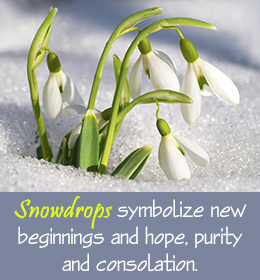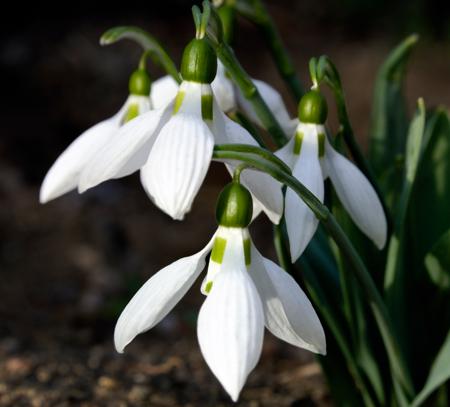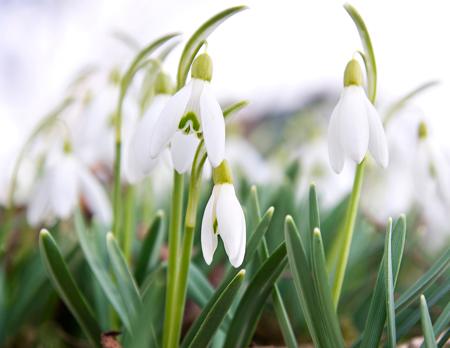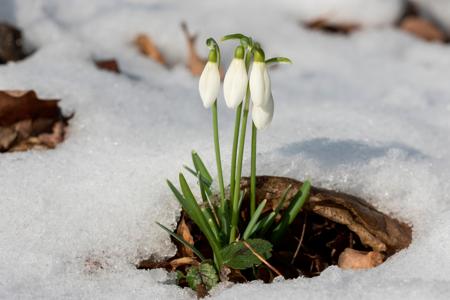





 Homer's epic poem, Odyssey says that the god Mercury (Hermes) gave Ulysses a herb known as Moly, which made Ulysses resistant to the forgetfulness poisons of the witch Circe, and destroyed the amnesia that Circe had imposed on his crew. It was suggested that the moly was really a snowdrop.The snowdrop is an early flowering bulbous plant. It is a genus of around 20 species, and belongs to the family Amaryllidaceae. It is native to Europe. The flowers hang down loosely giving the impression of modesty. They have a creamy white color. The leaves are narrow, long, slender, grass-like, and bluish-green in color. They can survive in any type of soil, but they grow well in rich and moist soils. They herald the coming of spring and end of winter. Snowdrops have been seen as a symbol of purity and hope since a very long time. Because of the similar appearance on all their species, there are only two species cultivated; the Galanthus elwesii, or the giant snowdrop, and Galanthus nivalis, or the common snowdrop.
Homer's epic poem, Odyssey says that the god Mercury (Hermes) gave Ulysses a herb known as Moly, which made Ulysses resistant to the forgetfulness poisons of the witch Circe, and destroyed the amnesia that Circe had imposed on his crew. It was suggested that the moly was really a snowdrop.The snowdrop is an early flowering bulbous plant. It is a genus of around 20 species, and belongs to the family Amaryllidaceae. It is native to Europe. The flowers hang down loosely giving the impression of modesty. They have a creamy white color. The leaves are narrow, long, slender, grass-like, and bluish-green in color. They can survive in any type of soil, but they grow well in rich and moist soils. They herald the coming of spring and end of winter. Snowdrops have been seen as a symbol of purity and hope since a very long time. Because of the similar appearance on all their species, there are only two species cultivated; the Galanthus elwesii, or the giant snowdrop, and Galanthus nivalis, or the common snowdrop. Also known as Fair maids of February, Mary's tapers, Snow piercer, Dingle-dangle, Bulbous violets, Emblem of early spring, or Candlemas bells, the snowdrop symbolizes hope and the beginning of something new. This is because it blooms at the end of winter and is a harbinger of spring. The blossoming of the snowdrop tells us that winter is slowly transforming into spring. Hence, the snowdrop symbolizes hope. It is the hope that the harsh winter will be over soon and warmth will come into our lives.Snowdrops also express sympathy, purity, optimism, and virtue. It is believed to help in overcoming the feeling of despondence and instill new confidence and courage within our minds. It is said to be of help in getting rid of pains and grievances of the past, and create an opportunity for happiness.
Also known as Fair maids of February, Mary's tapers, Snow piercer, Dingle-dangle, Bulbous violets, Emblem of early spring, or Candlemas bells, the snowdrop symbolizes hope and the beginning of something new. This is because it blooms at the end of winter and is a harbinger of spring. The blossoming of the snowdrop tells us that winter is slowly transforming into spring. Hence, the snowdrop symbolizes hope. It is the hope that the harsh winter will be over soon and warmth will come into our lives.Snowdrops also express sympathy, purity, optimism, and virtue. It is believed to help in overcoming the feeling of despondence and instill new confidence and courage within our minds. It is said to be of help in getting rid of pains and grievances of the past, and create an opportunity for happiness. Due to the low growing patterns of snowdrops and for the fact that they grow in cemeteries, many people think that these flowers represent death. So, bringing this flower home is considered unlucky.Legends About SnowdropsThere is a story about the origin of snowdrops. Adam and Eve had disobeyed God by eating the forbidden fruit. So they were outcast from paradise, Garden of Eden by the Angel. They sat outside the Garden of Eden in the lonely wilderness where no flowers blossomed and no birds sang. The earth was barren and unembellished. The trees were without fruits or flowers and the grasses were brown and dry. The snow continued to fall. Adam and Eve remembered the beautiful greenery and the colorful flowers of the garden which had once been lovely to stay in. Eve shivered due to the bitter cold and sat sobbing. God in heaven looked down and saw Eve weeping. He took pity and sent an angel to watch over them. The angel appeared to console Eve. The angel took a handful of snowflakes, ordered them to become flowers once they touched the earth, and blew them. As the snowflakes came in contact with the earth, they sprang up into beautiful white flowers. Eve smiled in joy as she saw the flowers bloom. The angel told Eve, "Take heart, dear Eve, be hopeful and despair not. Let this little snowdrop be a sign to you that the summer and the sunshine will come again." A number of snowdrops sprang up in the snow. This is how the snowdrop came to be a symbol of hope and of the promise of the end of winter and the arrival of spring.
Due to the low growing patterns of snowdrops and for the fact that they grow in cemeteries, many people think that these flowers represent death. So, bringing this flower home is considered unlucky.Legends About SnowdropsThere is a story about the origin of snowdrops. Adam and Eve had disobeyed God by eating the forbidden fruit. So they were outcast from paradise, Garden of Eden by the Angel. They sat outside the Garden of Eden in the lonely wilderness where no flowers blossomed and no birds sang. The earth was barren and unembellished. The trees were without fruits or flowers and the grasses were brown and dry. The snow continued to fall. Adam and Eve remembered the beautiful greenery and the colorful flowers of the garden which had once been lovely to stay in. Eve shivered due to the bitter cold and sat sobbing. God in heaven looked down and saw Eve weeping. He took pity and sent an angel to watch over them. The angel appeared to console Eve. The angel took a handful of snowflakes, ordered them to become flowers once they touched the earth, and blew them. As the snowflakes came in contact with the earth, they sprang up into beautiful white flowers. Eve smiled in joy as she saw the flowers bloom. The angel told Eve, "Take heart, dear Eve, be hopeful and despair not. Let this little snowdrop be a sign to you that the summer and the sunshine will come again." A number of snowdrops sprang up in the snow. This is how the snowdrop came to be a symbol of hope and of the promise of the end of winter and the arrival of spring. ✿ Snowdrops belong to the class Equisetopsida, subclass Magnoliidae, order Asparagales, family Amaryllidaceae and genus Galanthus.
✿ Snowdrops belong to the class Equisetopsida, subclass Magnoliidae, order Asparagales, family Amaryllidaceae and genus Galanthus. ✿ The flowers are pure white with drooping nodding heads. The term 'drop' is believed to mean earrings rather than a snow fall.
✿ The flowers are pure white with drooping nodding heads. The term 'drop' is believed to mean earrings rather than a snow fall. ✿ Snowdrops are a source of nectar for winter insects.
✿ Snowdrops are a source of nectar for winter insects.Copyright © www.100flowers.win Botanic Garden All Rights Reserved